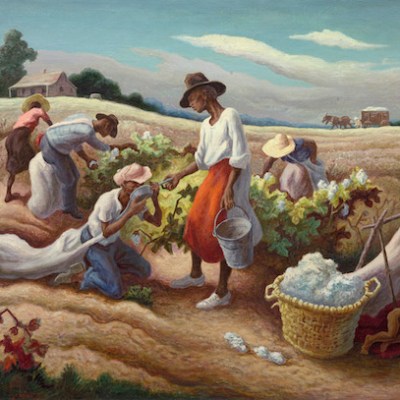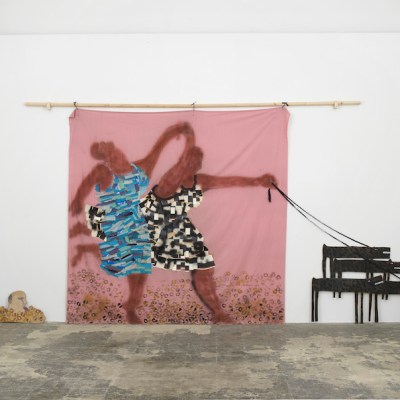In Claudette Johnson’s imposing, large-scale drawings and paintings, her subjects seem to fight against the confines of the canvas. Born in Manchester, Johnson was a key member of the Blk Art Group in the 1980s, a collective of young artists in the West Midlands which sought to amplify Black voices. ‘If anyone takes the time to look at what I’ve produced over the years, they’ll see that who I’ve chosen to portray is itself a political statement. At the same time, I want to speak to everyone, and I think what is coming through the work is something about our shared humanity,’ she has said. ‘Presence’, a solo show at the Courtauld Gallery in London (29 September to 14 January 2024), looks at how her approach to portraiture has evolved over the years with select works from throughout her career.
Where do you work?
I work in a bright and airy Hackney Wick studio run by Acme. It has one floor-to-ceiling window as well as four upper windows arranged over two walls. I love walking into the studio as I’m greeted by so much light. I have two very large easels on castors that allow me to move works around the room to view them from different angles. I also use the walls for works on paper. My studio looks out on to the local green – it’s a short walk from my house.
How would you describe the atmosphere of your studio?
Calm, welcoming, open. There’s not much furniture in the studio and most of the works are arranged around the periphery of the room so the centre of the space is fairly uncluttered. There’s a beautiful black leather two-seater sofa leant to me by a friend – that is the only bit of luxury in the room. The floor is covered in bits of masking tape that I’ve used to mark where sitters stand or sit. There’s also a significant amount of pastel dust, oil paint and gouache that has been ground into the floor over the years.
And I Have My Own Business In This Skin (1982), Claudette Johnson. Sheffield Museums. Photo: Ben Westoby; courtesy the artist and Modern Art Oxford; © Claudette Johnson

Is there anything that frustrates you about it?
It’s very cold in the winter and very hot in the summer. Once the temperature hits 25 degrees it’s impossible to get enough cool air circulating through the room as the windows, despite their number, don’t open very wide. In the winter, using more than two heaters blows the plug fuses so it’s never quite warm enough for me. I rely on my boiler suit and hot drinks to keep warm. Also my studio is a shared space and I find it too small for my needs. I can’t really get back from the work to view it from the appropriate distance. Consequently, I will be moving to a larger studio this autumn.
What’s your working schedule like? Are you an early riser or a night owl?
I’m more of a night owl though on the occasions when I have to be at the studio early, I realise I quite enjoy having a longer day, especially in the winter as I prefer to work with natural light. I often arrive late morning then I will work until seven, eight or nine at night. I work on a number of drawings or paintings at the same time, usually two or three. When I feel that I need to see a piece with fresh eyes I’ll cover it or turn it to face the wall and work on something else.
Claudette Johnson. Photo: © Anne Tetzlaff; courtesy the artist and Hollybush Gardens, London

Do you work with assistants?
I don’t currently work with assistants. In the past, I have been assisted by an artist friend who very occasionally has helped with priming paper and moving works on board from the easel to the wall. I mount the paper on to heavy boards, the largest of which is 1.83 x 1.6 metres, so I sometimes need assistance to lift the board from the easel. I have been considering having an assistant more regularly but I’m not sure that there would be enough to do.
Do you have a studio uniform?
I wear a boiler suit in the winter and dungarees in the summer. My current black boiler suit still looks quite smart as I bought it late last year and is a wonderful fit as it was made for a woman. My previous protective clothes were white decorators overalls, made for a man, that I never washed and were so thick with paint it was almost impossible to see their original colour. They were very baggy, quite ill-fitting really, with lots of pockets but also holes in a number of places where maybe white spirits or chemicals had worn away the fabric.
Figure in Blue (2018), Claudette Johnson. Arts Council Collection, Southbank Centre, London. Photo: Arts Council Collection, Southbank Centre, London; © Claudette Johnson

What do you listen to while you work?
I listen to quite a lot of jazz, reggae and soul/R&B. Occasionally I’ll listen to favourite arias, usually Verdi. If things are going well with the work I’ll sometimes listen to something quite upbeat such as Bruce Springsteen or Iggy Pop, but when I need calm and focus it will be John Coltrane, Miles Davis, Sarah Vaughan or Nina Simone.
Do you pin up works by other artists?
I have a postcard of Young Woman Sleeping (1664) by Rembrandt above my desk in the studio. It’s an ink study of a woman with her head on her arms drawn with great tenderness and skill. I like to think that she had fallen asleep and he decided to quickly capture the moment. There’s nothing superfluous in the drawing – there are just enough marks to describe her figure and indicate the dark surrounding her. His spare use of line is a guiding principle for me. I also have a postcard of a Dogon mask from Mali in West Africa. It’s a mask that was meant to be worn in ceremonies and it has a powerful atmosphere of something both spiritual and sinister.
Standing Figure with African Masks (2018), Claudette Johnson. Tate, London. Photo: Tate; © Claudette Johnson

What’s the most unusual object in your studio?
My skipping rope, maybe? I sometimes skip when I arrive at the studio or when I’m taking a break from drawing. It helps to release the tension in my shoulders that builds up when I’m drawing.
Who is your most frequent visitor?
I always feel anxious when people visit my studio. It’s exposing having work on view that is unresolved, and I feel very protective of the work when it’s in embryonic form. My most frequent visitors are my sitters. As painting is generally so solitary, it’s enjoyable having conversations with the sitters during breaks – I’m not able to hold a conversation when I’m painting as I become totally absorbed in the process. My granddaughter, who is five years old is quite a frequent visitor and although it is distracting having her there, it’s also hugely enjoyable. She loves drawing and gives me honest feedback on the work.
‘Claudette Johnson: Presence’ is at the Courtauld Gallery, London from 29 September to 14 January 2024.



